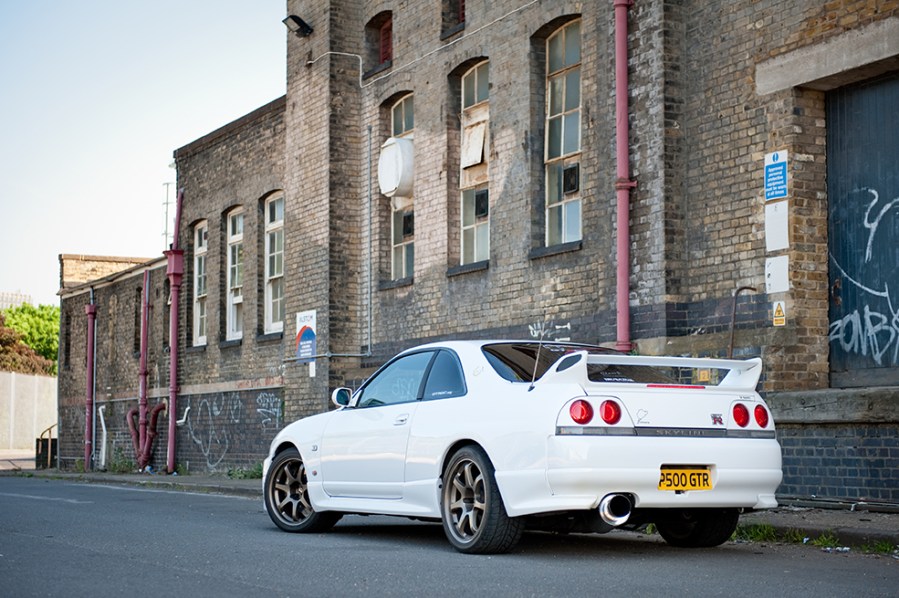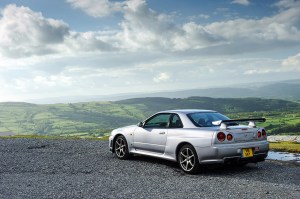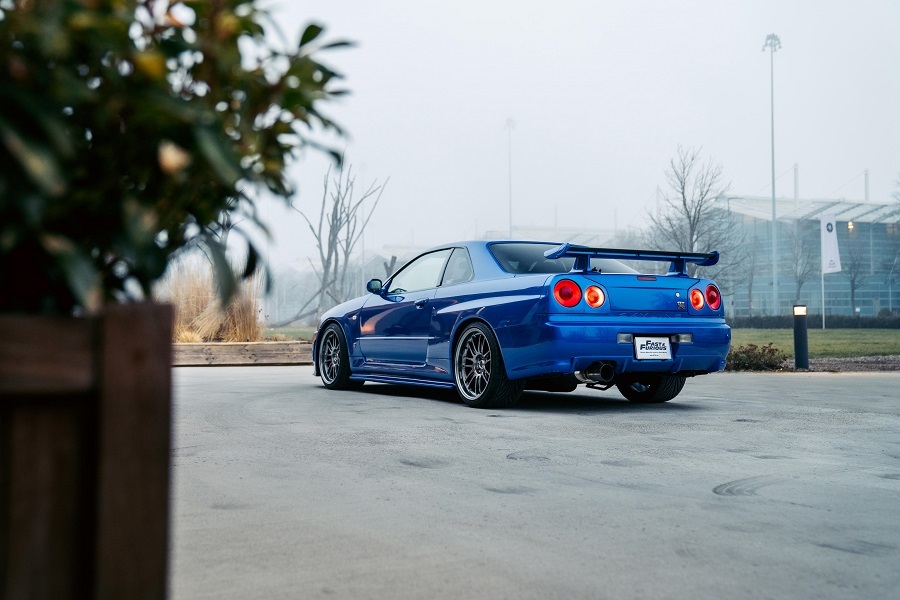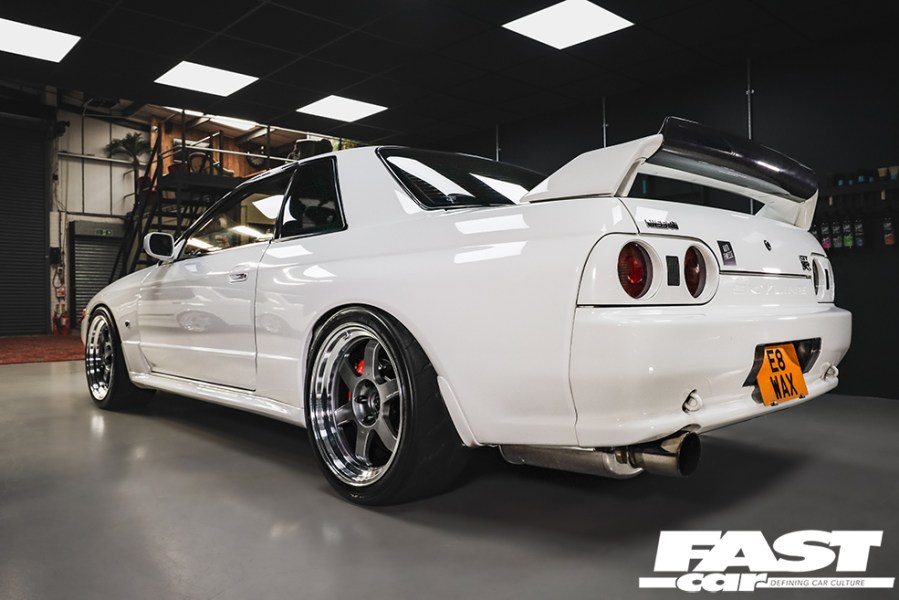Looking for the best exhaust for a Nissan Skyline GT-R? Well, here are some of our top picks from the performance aftermarket.
If you love the sound of an RB26 engine, then you’ll be wanting to unlock some of that sound with an aftermarket exhaust. Not only does it increase the sound, but you can release a few extra horsepower by switching to an uprated, freer-flowing system. Below, we’ve selected some of our favorite exhaust brands available for the blistering Nissan Skyline GT-R. We’ve broken down options for each generation, including the R35 GT-R. So without further ado, here’s our guide to the best exhaust for the Nissan Skyline GT-R.
Best Exhaust for a Nissan Skyline GT-R R32
What’s it like as standard?
When the R32 generation Nissan Skyline GT-R arrived back in 1989, it was a massive step forward for Nissan – both visually, and dynamically too. Its all-wheel drive ATESSA-ETS system and Super HICAS rear steering stole many headlines, as did the Skyline’s new engine, the ‘RB26’.
This in-line six-cylinder engine would go on to become one of the most revered power units within the tuning scene, but even in stock form, it was pretty handy. That translated into a fruity exhaust note, but hey, there’s always room for improvement…
Thinking of bagging yourself an R32? Have a read of our dedicated buying and tuning guides.
Tomei
Tuning engines for racing is Tomei’s bread and butter. Over the years, they’ve developed a reputation for precision craftsmanship. As you’d imagine, Tomei carries this method of work into its exhaust design, resulting in a set-up that is strong, light, and complementary to any mods made within the engine bay.
The Tomei Expreme TI cat-back ($1408) system is a highly desirable aftermarket option for the R32 Skyline. Built from titanium, it’s 12.5kg lighter than the standard exhaust system and incorporates minimal pipe curvature for optimal gas flow. The regular package is a cat-back system only, making it street legal. However, if you intend to keep your R32 on the track, Tomei also sells a decat straight-pipe add-on ($293) for further performance & sound gains.
GReddy
The GReddy EVOlution GT cat-back exhaust system ($689) aims to combine performance, sound, and style, at a more attainable price point. The system features 3-inch wide exhaust piping and improved ground clearance over some of GReddy’s older products. You also get GReddy’s ‘EVO’-spec Helmholtz canister and a resonator in the center pipe, designed to minimize the amount of unwanted drone that can be heard from inside the cabin.
GReddy has constructed this exhaust from stainless steel rather than titanium like the Tomei product above, but that helps to keep the costs down. Overall, it’s still a highly commendable, street-legal exhaust upgrade for your R32 that’ll hit 100 decibels at 5600rpm! Click on the video above to hear what it sounds like.
HKS
Recognized for their iconic ‘oil splash’ house colors, HKS is one of the strongest JDM performance brands around. The HKS Super Turbo ($1022) exhaust system has been designed with the intention of creating a sporty, yet socially considerate exhaust note. In other words, it sounds nice, but isn’t deafening.
HKS describes the Super Turbo muffler as “comfortably quiet” around town, but able to provide a “unique aggressive sound” when accelerating hard. To see what they mean, check out the video listed above.
Of course, as with any performance exhaust system, it’s not just about the sound it makes. HKS has also built it to support the gas flow of more powerful, modified engines, as well as what the regular RB26 produces. Back pressure reduces too, compared to the standard R32 exhaust.
Best Exhaust for a Nissan Skyline GT-R R33

What’s it like as standard?
Nissan carried over the hugely popular RB26-DETT engine from the R32 into the R33 generation of Skyline GT-R. However, in between the two iterations of the car, Nissan’s team of engineers managed to extract some extra torque from it.
As for the exhaust, both cars run a similar design, though whereas the R32 featured an iron exhaust, the R33’s is constructed from stainless steel. The R33’s pipework is also slightly smaller in diameter. Sound-wise, there’s little to differentiate between the two cars.
If you’re looking at buying an R33, or tuning one, be sure to check out our handy model-specific guides!
Tomei
Good news! Given the structural similarities between the R32 and R33, Tomei’s Expreme TI exhaust system ($1474) is also available for the R33 (and the R34 as well, actually).
So, regardless of whatever age or model year your Skyline GT-R is, you can benefit from one of Tomei’s most popular products. Just like the R32-spec system, this exhaust is fully constructed from titanium, while lighter clamps and springs hold the system together rather than conventional flanges. You also get a high-flow silencer and pipework that’s been built as straight as possible, improving sound and performance.
Watch the video above for an in-depth look at how the Tomei Expreme TI set-up sounds from both inside and outside the car.
Fujitsubo
The Fujitsubo Legalis R exhaust system ($820) is a great way of enhancing your R33’s sound, without falling foul of any local noise or emissions regulations. As this is a cat-back system, the car’s catalytic converter remains untouched. Plus, by incorporating a mid-positioned muffler in addition to the large exit muffler, noise levels are kept down to sociable levels.
That’s not to say that this exhaust system is boring, by any means. Give it a listen in the video above to hear for yourself. Instead, the Legalis R is a great option for people who want to give their R33 a slightly deeper, more satisfying tone, without annoying their entire neighborhood.
This exhaust system is about 50% lighter than the stock R33 exhaust, but as its made from stainless steel rather than titanium, it’s still not as light as the Tomei Expreme TI. Nevertheless, you should still see some small gains in horsepower and torque when you put the car on the dyno, thanks to a straighter pipe design.
HKS
As the video above proves, the HKS Silent hi-power exhaust system is still anything but quiet when you really put your foot down.
Crucially, it’s a street-legal cat-back system, which HKS describes as being for the more ‘mature’ enthusiasts. In normal conditions, the Silent hi-power system causes minimal disturbance in the car’s surrounding environment. The same is true for the experience inside the cabin. HKS makes use of what it calls a “silent chamber” and sound-deadening Advantex glass wool to minimize the amount of annoying drone and resonance that comes through into the car’s interior.
If you prefer the HKS Super Turbo muffler ($1025) that we listed above for the R32 GT-R, fear not, as that system is available for the R33 as well.
Overall, we’d place the Silent Hi-Power system somewhere between the Tomei and the Fujitsubo in regards to noise level. Happily, its price reflects that too, currently available at Nengun for $937.
Best Exhaust for a Nissan Skyline GT-R R34

What’s it like as standard?
Nissan’s customer base and affiliated tuners couldn’t get enough of the RB26-DETT that featured in previous Skylines, so the engine remained in place under the R34’s hood too.
Its stock exhaust system closely resembles the stainless steel one that you’d find on (or rather, under) an R33, though the newer R34 version weighs in at just under a kilogram lighter.
Again, expect a near identical stock exhaust note. But hey, that’s no bad thing. Considering your own R34 project? Then be sure to check out our buying and tuning guides for the car.
Blitz
It’s worth pointing out that you can buy R34-specific versions of many of the exhaust systems mentioned above. However, if none of those options have floated your boat so far, here’s three further aftermarket exhaust systems that will help your R34 Skyline to sing.
The Blitz NUR-spec R exhaust system ($681) is one that is available for a large number of iconic Japanese sports cars, and the R34 is no exception.
Being a direct bolt-on cat-back replacement, this Blitz system is perfectly road legal. It features a much straighter pipe design than the standard OEM exhaust to help minimize back pressure and enhance performance higher up the rev range. As an added bonus, it also raises the car’s volume.
Construction-wise, the exhaust is hand built from stainless steel and TIG-welded by Blitz’s top craftsmen. As a package, the Blitz NUR-spec R has been tried and tested by the company and customers alike for the best part of two decades now, so you can be sure that it’s a product which won’t let you down. Check out the video above to hear if you like the way it sounds.
Mine’s
Mine’s is a Japanese tuning company famed for its hardcore mechanical upgrades, often paired with comparatively restrained exterior styling. To see what we mean, check out this feature we did a little while ago, highlighting a rare Mine’s R34 demo car!
In fact, the cat-back muffler we’re referencing here is the same kind that’s used on that demo car. The Mine’s Titanium Silence VX-Pro Titan exhaust is certainly one of the more expensive options out there, priced at $2493 on Nengun. However, you’re getting a truly premium product for the money. Like the Tomei Expreme TI system ($1412), this Mine’s exhaust is fully constructed from super-lightweight titanium (as its long-winded name suggests), rather than steel. It’s also been designed to complement even the most outrageously tuned RB26 engines, having been developed and stress-tested over many years in Japan’s grassroots racing series.
Watch the video above to hear how it sounds in practice, though keep in mind that the car featured in this example is also running a Mine’s frontpipe ($1475).
Nismo
Last but by no means least, here’s the Nismo N-E1 exhaust system, manufactured by Nissan’s official motorsports division.
The N-E1 package is a full exhaust system, rather than just a cat-back device, hence why it costs significantly more than the other options listed in this article. That means that on top of the rear pipework and muffler, the Nismo package also includes a high-flow sports catalytic converter. In short, better performance gains and an even better sound, without losing anything in emissions compliance.
The N-E1 exhaust registers a maximum of 88 decibels, which is quieter than many of the other aftermarket options listed here. Still, that doesn’t have to be a negative thing. It just ensures that you’ll benefit from an enhanced exhaust tone without totally deafening yourself or those around you.
There are actually two variants of the N-E1 exhaust to choose from; either stainless steel or titanium. The titanium one is a lot harder to source these days, and is more costly, but weighs 10kg less than the steel version (12.5kg lighter than standard). Back pressure reduces by 7% compared to standard. That said, even though it comes second to the titanium package, the stainless steel N-E1 exhaust is still a highly capable product, as its $4356 price tag suggests.
As you might expect from an official Nissan-affiliated product, the N-E1 exhaust system is also available for the R32 and R33 generations of Skyline GT-R.
How to buy the best exhaust for a Nissan Skyline GT-R
It doesn’t matter whether you’ve got a Skyline GT-R or an R35 GT-R, with an aftermarket exhaust, you’ll never want to leave the throttle pedal… But, there are a few factors you need to consider when upgrading. Firstly, why are you upgrading your exhaust? Is it for extra performance? Perhaps it’s just an increase in volume you’re after. Or maybe you want more performance and more sound. The first thing to consider, and is the same principle you should use on any car when upgrading the exhaust, is to consider the diameter of the exhaust pipes.
If you’re planning on modifying other performance parts, an increase in size can be a good option. You could aim for a 3.25inch but we would recommend going 3.5inch if you’re aiming for big power (think 600bhp+). On the RB26DETT engine, as featured in the Skyline GT-R models, the biggest shortfall in the whole exhaust system is the downpipes. Mainly because most opt to ditch the factory twin-turbo set up, opting for a big single turbo. The design of the downpipe will be entirely different for each application.
As for sound, how do you plan on using the car? If you’re looking to utilize the Skyline’s on-track prowess, you’ll be needing a free-flowing exhaust but one with silencers to adhere to noise limits. If you’re just driving on the road, the world is your oyster. Although too loud and you’ll have the Police to deal with…
Exhaust material
Finally, the material of the exhaust. On the GT-R models, it’s not uncommon to find titanium exhausts as readily-available as stainless-steel, such is the diversity of the Skyline tuning scene. Titanium exhausts will change the pitch of the engine note ever-so-slightly, so if you’re wanting something with more rasp at the top end, aim for titanium. It’s more expensive, guaranteed, but they’re lighter and produce an epic sound. In terms of performance, a titanium exhaust in itself won’t improve your topline figures, that’s down to the exhaust flow.
Still in need of some inspiration? Check out our top Nissan Skyline GT-R feature cars!






